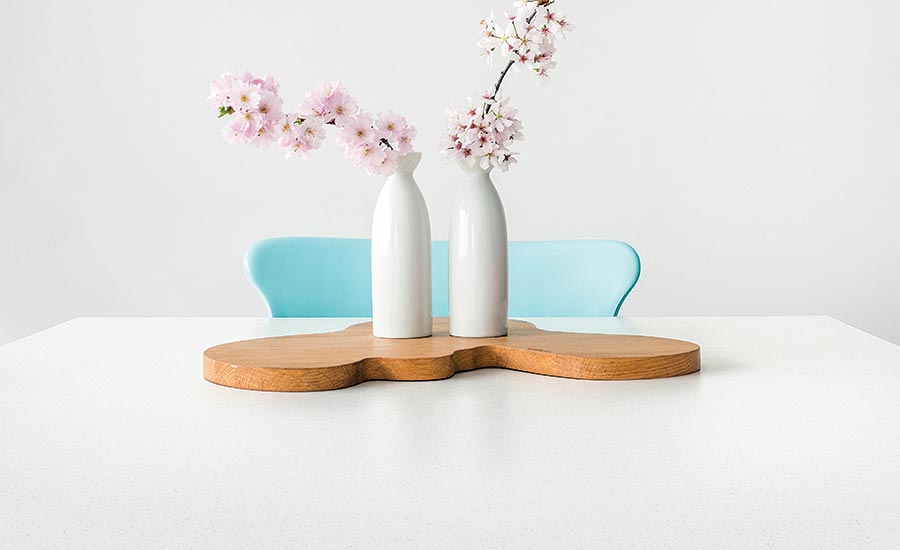Tim Culot is among the leading stone fabricators in Belgium and has experienced success with cutting Dekton, although he admits there was a learning curve. During a presentation at Cosentino’s C100 conference, he shared that 40% of all the material he cuts is now the sintered stone material. The following are thoughts Culot has on his own experience fabricating Dekton, as well as where he sees the trend going with fabricators in the U.S. Additionally, Valentín Tijeras García, product and R&D corporate director for Cosentino Group, discusses his predictions for Dekton in the U.S. market.
You’re one of the leading fabricators of Dekton in Europe. How and why did you first start working with Cosentino products? What did you first think when you were introduced to Dekton?
Culot: We started working with Silestone from Cosentino in the early nineties. When Cosentino started talking about Dekton around 2011-2012 we were very eager to start working with this new material with all the advantages that it offers. We truly believed in the qualities of the product and that it would be a success and soon a need for the market.
We had to wait until halfway through 2013 to get the first slabs and when we got them we discovered it would not be a piece of cake.
What are your key points of success in fabricating the material with such success, speed and precision?
Culot: First of all, my belief in Dekton. I was sure Dekton would become a great product. The start was hard -- just like the material. But we remembered the troubles we had when switching from natural stone (granite and marble) to quartz materials and later also to ceramics. We could count on that experience.
But again, it was a daily fight to motivate our workers to continue. Production ran behind, costs were exceeding the gains, our machine and tool suppliers all had to think how to adjust their products to be able to work with Dekton. It’s a real learning process that requires teamwork to do what we do. But you also need to be stubborn and just want to go forward and believe that you can. Every day, we keep working for better, as good is not enough. We keep pushing the boundaries. It would be easy to work only with our waterjets, but this would make the product too expensive and it needs to be available for every project.
You’ve been working as a fabricator for many years -- what changes have you seen in the surfacing industry over the last 20 years?
Culot: The change of materials! Since the start of our company around 1895, we have been working for over 100 years with only natural stone. Then came the quartz materials (composite materials). We saw a progressive change from 100% natural stone to 30% natural stone and 70% quartz materials between the nineties and 2011 more or less. This is also due to the fact that more people put more budget in the kitchen as it’s become a living area not only for cooking anymore.
How do you predict the surfacing industry will change over the next 20 years?
Culot: I believe that with Dekton now we have covered a gap in the industry. For me Dekton is the future and the future is now. I’m sure Dekton will continue growing fast. But I’m also sure that there will be an evolution because a lot can happen in 20 years. It is possible that new materials will be coming on the market. What’s also certain is that existing materials will be improved and developed even more. We already see the evolution of Silestone. The product has been modified to make cleaning it much easier (eg. Suede, NBoost) and also the evolution of marble looks that are more and more realistic, all due to new technologies that are being developed every day.

What do you find exciting about working with Dekton?
Culot: The challenge! You know the material is great and we continue to push the limits with the material. Also, the growing demand, [as well as], there are very nice new colors and the discovering of new applications with/for Dekton.
Out of the surfacing material you fabricate, what percentage of it is Dekton?
Culot: At the moment, we do about 15% natural stone, 40% quartz material (Silestone) and 45% Dekton. So from the end of 2013 until now, the shift in materials was the biggest we’ve ever seen.
Why do you think Dekton is growing so quickly in popularity?
Culot: People believe in Dekton qualities. Who would say no to a kitchen that you can use, your children can play in, and friends can party in with nearly no risks of damage for your countertop? In today’s society it’s all about work, work, work and people need more quality time. So when you can have a countertop where you don’t need to worry about stains, cleaning immediately after cooking and where you can put a cooking pot straight from the hob to the top without problems… This is what the majority of our customers want.
How does the surfacing industry in Europe compare to the American market?
Culot: There is definitely a big difference in terms of taste, trends and colors. In America, there is a real granite culture. Even quartz hasn’t been on the market for so long and is only now gaining popularity.
What changes have you seen in consumer preferences from Europe to the U.S., both in the uses of the material and popularity of certain colors?
Culot: We see that in the U.S., the percentage of natural stone is still very high. Our customers could classify some of the popular materials as old-fashioned. They don’t want what their parents and grand-parents had. They want it more modern.
However, we still have a percentage of customers that prefer the real thing (natural stone) and don’t want man-made products. Therefore, we are also always looking for new marbles, granites and quartzite.
As to our market, we see that at the moment and for some time already, 50% is composed of white and black colors. In Europe, people don’t swap houses easily and are afraid to be bored too soon by a special design so they just go for practical, sober and blending into the design.
We also see that we already made the transition to thinner countertops. Less is more, more straight designs, no curves, no special molding edge finishing.
From Cosentino, we know that one of their quartz colors is number one in sales in the U.S., but we barely sell this color a handful times a year.

What color trends are you seeing, and what colors do you anticipate to grow in popularity in the coming years?
Culot: As the demand for marble looks keeps growing, the Silestone and Dekton alternatives will be very important, from lighter to darker colorways. And with the new techniques and technologies for both Dekton and Silestone possibilities, I’m positive they will keep developing this segment and that the colors will be very realistic and not just “a copy” or “imitation.
A recurring topic that came out of C100 is that the future is Dekton. We are already seeing key markets in Europe where Dekton is emerging as the most popular surfacing material. What is your forecast for Dekton in Europe over the next five years? How soon do you anticipate it will be before we see this in the U.S.?
García: In five years, I forecast for Dekton a dominant position in the market. Similar to what quartz (Silestone) means today. Sales are growing super fast, and new designs are more and more appealing every day. As for the U.S., my bet is that in the next two years we are going to be reaching a turning point and will start to grow exponentially.
What parallels do you see from the introduction of Silestone to the surfacing industry 27 years ago in comparison to Dekton? What are the similarities? What are the differences?
García: As for the similarities, the same skepticism of the market at the beginning and the hard work to change fabricators’ mind about the product. As for differences, now Cosentino has a bigger sales muscle and there’s much more access to information from customers so the change has happened faster.
Tell me about Cosentino’s relationship with Tim Culot and training him in fabricating Dekton. Is he doing exactly as instructed, or has he discovered other methods that allow him to cut it faster?
García: We just showed him some tricks. All the credit is to him. Hard working, motivated and smart fabricators are working with unprecedented speed and quality.
What can fabricators in the U.S. learn from Culot and his business?
García: How passion, perseverance and drive can transform a business to adapt to new times and become bigger and stronger.




